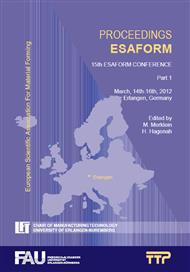p.41
p.47
p.53
p.59
p.65
p.71
p.77
p.83
p.89
Using Cross Stamping to Test Zinc Sheets Formability
Abstract:
Sheet metal formability has been studied for a half century. The sheet formability is mostly described by the Forming Limit Diagram (FLD). A prediction of this FLD is a source of interest for industrial companies. Indeed knowing the FLD of a material allows optimization of the production processes which leads to money saving. Nevertheless, the formability tests (tensile, bulge and Nakazima tests) which give the experimental FLD do not really represent the process that the sheet will undergo in industrial conditions. The paper therefore focuses on a cross stamping test. The material of interest is a Zinc sheet. FLD prediction is reported for a wide variety of metals [1] but literature about Zinc is nearly non existent. The studied Zinc sheets exhibit a highly anisotropic mechanical behaviour due to the hcp lattice structure and the inherited rolling texture. This anisotropic behaviour results in an anisotropic formability. The Zinc sheet FLD is influenced by the orientation of the rolling direction during the process. Experimental cross stamping of this material allows describing the studied material behaviour in a large range of mechanical solicitations from tensile to biaxial tension. The experimental results are compared with the finite element simulation and permit to understand where and why failures appear, which leads to a better understanding of Zinc anisotropic formability.
Info:
Periodical:
Pages:
65-70
Citation:
Online since:
February 2012
Authors:
Keywords:
Price:
Сopyright:
© 2012 Trans Tech Publications Ltd. All Rights Reserved
Share:
Citation:


